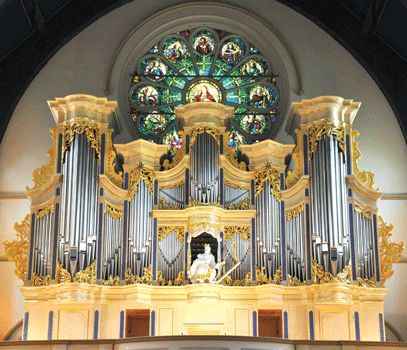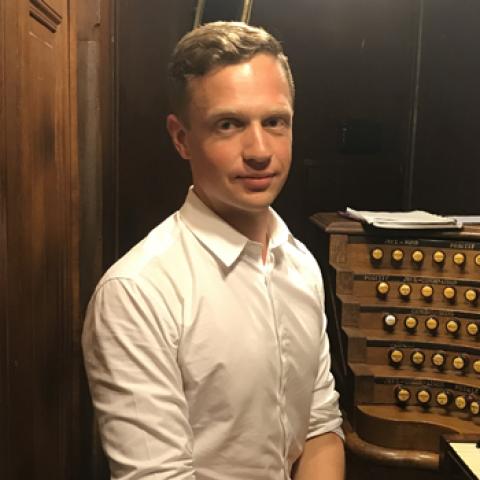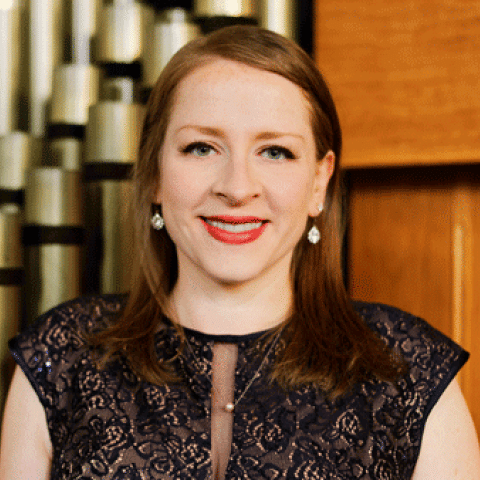When I reviewed the 2009 Organ Historical Society Convention in Cleveland, Ohio, I remarked on the evolution of such gatherings from their mid-century beginnings: long gone were the days of the un-air-conditioned school bus with bad springs on dusty back roads visiting a bevy of two-manual, nineteenth-century Hooks, Simmonses, or Johnsons. The feel of the modern OHS convention is one altogether more sleek and polished, and the Rochester convention, ably led by co-chairs Myles Boothroyd and Nathan Laube, continued this trend in spades. As over 400 attendees discovered between July 28 and August 4, Rochester’s OHS convention was a delicious buffet of thirty-six instruments spanning four centuries of organbuilding, demonstrated by thirty-five recitalists.
First and foremost, the tremendous number of young people at the Rochester convention must be mentioned. Thanks in large part to continued generous financial support from Paul Fritts, the E. Power Biggs Fellowship program was able to grant twenty-eight fellowships this year, providing travel, lodging, and convention registration to those attending an OHS convention for the first time. Bravo to the OHS and Mr. Fritts for the dedication to this important program that brings new, younger members to the OHS.
Unlike other national or regional organ gatherings, the intent of OHS conventions has always been to focus on the organs. To that end, the successful OHS recital is one that puts the instrument first, presents it in its best and fullest light, and approaches it on its own (often historic) terms. By and large, most recitals heard in Rochester fit this bill. Thirty-three events cannot be adequately covered here, so a sampling of those that stood out in this mission will have to suffice.
Saturday, July 28
The pre-convention day took attendees to Ithaca, home to a number of new instruments in recent years. The newest instrument heard at the convention, the 2016 Juget-Sinclair at Saint Luke Lutheran Church, was played by Belgian organist and musicologist Joris Verdin. An unwelcome acoustic and placement presented the builders with a challenge to be sure in building a French Romantic-style instrument. Mr. Verdin’s program was a welcome surprise for this reviewer. Rather than choosing a typical program of large works by Widor, Franck, Guilmant, and their ilk, Verdin programmed no fewer than ten smaller pieces by less-celebrated composers including Lemmens, Benoist, and Théodore Dubois, all played with sensitive expressivity, demonstrating his thorough mastery of this music. Excepting the Troisième Choral of Franck, none was longer than four to five minutes; all of different characters, they were a superb demonstration of the organ’s many guises. With mature reserve, Verdin held the organ’s tutti back until fully the fifth piece of the program, finally washing the audience in the rich, but hardly overpowering full organ. The convention’s first recital was indeed a primer on the perfect OHS demonstration.
Monday, July 30
The convention’s highpoint occurred on Monday evening, at Saint Paul’s Episcopal Church on East Avenue, Rochester, home to a recently restored Skinner organ, Opus 655. Ken Cowan and Bradley Hunter Welch shared the bench in a duet program that was, from the opening Tuba Mirabilis fanfare of the Shostakovich Festive Overture, positively electric. Truly sounding as one player, the two milked every possible color out of the sixty-eight-rank instrument, but in a natural way; not color for color’s sake. Natural, too, was the shaping of phrases whether with swell shades or rubato, particularly in the “Larghetto” from Elgar’s Serenade for Strings, played by Mr. Welch, who always seemed to leave just a little bit more box left, whether opening or closing. Mr. Cowan’s maiden voyage of Karg-Elert’s programmatic Improvisation on “Nearer My God, to Thee” showed him an equal master of expression and color, including a haunting statement of the theme on the Echo Vox Humana. With the closing duet arrangement of “Toccata” from Jongen’s Symphonie Concertante, one might have expected the console simply to burst into flames for all the energy being pumped into it. The audience immediately leapt to its feet in a roundly deserved standing ovation. Best of all, both during the playing and in the exquisite program notes given by both Cowan and Welch, it was patently clear they were having a blast with this performance.
Tuesday, July 31
Most of the day on Tuesday was spent visiting rural communities an hour’s drive south of Rochester. At Leicester Evangelical Presbyterian Church in Leicester, New York, an 1876 Steer & Turner was aptly demonstrated by Malcolm Matthews, currently a doctoral student at Eastman School of Music. Matthews’s program featured two selections from Joseph Jongen’s Quatre Pièces, opus 37. His elegant performance demonstrated many of the possible combinations of 8′ and 4′ stops as well as the 8′ Oboe and Bassoon, in a variety of musical textures. Overall, this instrument has a warm and pleasing sound that is gently present in the room. The program concluded with Mendelssohn’s Sonata No. 4. Marked “Allegro con brio,” the first movement of this sonata often comes across as bold and declamatory. This instrument led Matthews to a more nuanced rendition that balanced strong rhythmic drive with subtle flexibility to make room for interesting melodic and harmonic details.
At Rochester’s Downtown United Presbyterian Church, C. B. Fisk’s 1983 Opus 83, the last organ finished by Charles Fisk himself, was the vehicle for Annie Laver, assistant professor of organ at Syracuse University. The organ is known for its forceful presence in the room, and Laver skillfully uncovered the instrument’s gentler sounds in a set of variations by Dirck Sweelinck, featuring several of the 8′ flutes, solo 4′ stops, and combinations such as the Swell 8′ Cor de Nuit and 2′ Waldflöte. Her performance of Bach’s Toccata in C, BWV 566a, was declamatory and bold with a wonderful sense of rhetorical gesture. Her treatment of the first fugue was particularly delightful, with the Positive 8′ Trechterregal and 4′ Baarpijp evoking a spirited Renaissance consort. Laver worked seamlessly with her two registrants to create a kaleidoscopic sound spectrum and a grand sense of architecture while lavishing appropriate care on many expressive details.
Wednesday, August 1
Michael Unger’s performance on the 2008 Taylor & Boody organ at Pittsford First Presbyterian Church was a buffet of eighteenth- and nineteenth-century music appropriate to the organ, based on those of David Tannenberg. The organ itself is a study in miniature, both physically and tonally, with “expected” eighteenth-century sounds present, but at a volume appropriate to the small size and acoustic of the church. If the organ was a bit too lieblich to keep up with the roaring audience in singing “Love Divine, all Loves Excelling,” it provided delicate and exquisitely-voiced color and choruses for the literature Unger chose. Mendelssohn’s Andante with Variations in D was intimate and delicate, with lieblich strings and flutes, while Kellner’s Prelude on Was Gott tut das ist wohlgetan brought out the sprightly side of both organ and player, both the flute-based accompaniment, and the haunting vowel color of the Vox Humana cantus firmus.
Thursday, August 2
While heavily altered since its construction by Henry Erben in 1840, the fourteen-stop organ at Grace Episcopal Church in Lyons was the medium for another textbook demonstration recital by Jonathan Moyer, who established a congenial rapport with the audience with his good-mannered welcome. Nine pieces, none longer than five minutes, included Wesley’s Voluntary IX, highlighting the organ’s delicate 4′ flutes, and Mendelssohn’s Thema mit Variationen, whose theme was introduced nearly inaudibly by the 8′ Dulciana. Finally, it did not go unnoticed that we heard full organ exactly once, at the end of August Gottfried Ritter’s Variationen über des Volkslied “Heil dir im Siegerkranz” to close the program.
Friday, August 3
Friday was unit organ day, noting the rich history of Robert Hope-Jones and the import Rochester played in his early success in the United States. Eastman graduate and organbuilder David Peckham demonstrated Hope-Jones Opus 2 at Rochester’s Universalist Church. Under Peckham’s capable and sympathetic hand, the larger of only two Hope-Jones organs remaining in the United States was a revelation to many who expected to hear a loud, dull, lumbering octopod. Despite its horseshoe console, this decidedly non-theatre organ was the successful vehicle for a varied, colorful program, running the gamut from David Johnson’s Trumpet Tune in D, showcasing the organ’s spectacular Tuba, to Chant de Paix of Langlais, pairing Violes d’Orchestre with Tibia Clausa to ethereal and beautiful effect. Finally, the singing of “Praise the Source of Faith and Learning,” set to the tune Procession by William Albright, was a profoundly moving experience, given the regal nature of the tune, the rock-solid accompaniment, and the thrilling support of the organ, undergirded by the thundering 16′ Ophicleide. After a century of derision and misunderstanding, Hope-Jones and his instruments surely won some reconsideration, and much credit is due to Mr. Peckham for presenting the organ so spectacularly and sensitively.
Saturday, August 4
Saturday, the convention’s final optional day, began with a visit to Saint Mary’s Catholic Church in Auburn, New York, where David Baskeyfield demonstrated the Carl Barckhoff instrument (two manuals, twenty-six ranks), built in 1890. This is an exquisite instrument in a beautiful Gothic Revival church designed by Patrick Keely, with glorious acoustics. From the opening notes of Bruckner’s Vorspiel und Fuge in C Moll, Baskeyfield revealed his masterful artistry, creating a brooding and imposing atmosphere through careful attention to building long phrases. Works by Robert Schumann and Charles-Valentin Alkan demonstrated further color possibilities. Notable among the organ’s ten 8′ stops are the powerful Doppel Flute and Gamba on the Great. At times the Doppel Flute clearly stood out in a soloistic capacity, while elsewhere it was used in fuller combinations of foundations stops to give a melodic line subtle prominence.
Hymns
A fixture of every OHS convention is the lusty hymn singing at each recital: an opportunity for performers to demonstrate what, for most pipe organs, is their primary purpose. Good hymn playing takes work and preparation, and this discerning audience can tell when hymns have been well prepared, and when they are last-minute afterthoughts. The Rochester convention had some truly outstanding accompaniments, mostly taken from Rollin Smith’s Empire State Hymnbook, a compilation of texts or tunes with New York connections. Several hymns stood out: Eastman professors William Porter and David Higgs, both performing on historic reconstructions, elected to adopt an historic approach: playing the entire hymn organo pleno, at what we would today consider about half tempo or slower. Both Porter’s Lasst uns erfreuen and Higgs’s O Gott, du frommer Gott were rock solid—not an easy feat when accompanying several hundred singing at such a tempo—and wholly supportive, Porter’s being particularly expansive, and provided convention goers with a wholly different experience in hymn singing. On the 1893 Hook & Hastings at Rochester’s Christ Church, OHS favorite Christopher Marks was clearly singing along and breathing with the congregation during “Because thy Trust is God Alone,” to the tune Marthina by J. Christopher Marks (no relation!), and would absolutely not let the audience drag, despite its best efforts.
Lectures
Aside from performances, three lectures broadened the scope of offerings at the Rochester convention. Joris Verdin’s discussion of the harmonium, and particularly the historic desire for expression in keyboard instruments, was a valuable insight into an instrument that influenced many of the French Romantic composers whose organ music has become staples of our repertoire. Joel Speerstra, from the Göteborg Organ Art Center (GOArt), used three case studies to explore affordances—unintended consequences and discoveries of new ways to use reconstructed historic instruments. Finally, the present author delivered a review of Robert Hope-Jones’s career, and his position as the last truly forward-looking organbuilder.
In closing, a single word of criticism, particularly given the number of younger people attending and performing at this convention: at its very core, the OHS should promote approaching historic instruments on their terms, and promote an understanding of how to play them in a way that respects their builder’s intent. Apologizing for the historicity of some instruments should be anathema at an OHS convention recital, and yet I found it disturbingly common, particularly from young performers, in reference to original combination actions. Whether jokingly complaining or taking five minutes between every single piece of a program to reset pistons, some performers’ desires that these instruments be something they are not was occasionally plainly evident. This reviewer hopes the OHS will remain steadfast to its mission to foster an environment that first and foremost presents historic pipe organs in their best light and remind their performers that it is the organ’s chance to shine, not necessarily theirs. In this vein, Robert Poovey’s masterful use of Skinner Opus 517 at Rochester’s Church of Saint Luke and Saint Simon Cyrene deserves mention. Observing from the page turner’s position, I witnessed Dr. Poovey’s carefully planned use of the organ’s resources: with ample use of divisional pistons and hand registering, he reset the organ’s two general pistons exactly once, all the while giving a masterfully thorough demonstration of the instrument.
All in all, every attendee, whether a veteran OHSer or a Biggs fellow, must have come away from Rochester with an undeniable sense of the good health of the OHS. Kudos to all those involved in planning this lively social gathering of like-minded organ aficionados coupled with a highly polished performance program. The OHS should be rightly proud of the showing in Rochester; with events of this caliber, the future of the Organ Historical Society is in good hands.
Photo: West Bloomfield Congregational Church, West Bloomfield, New York, 1880 William J. Davis organ (photo credit: William T. Van Pelt)




